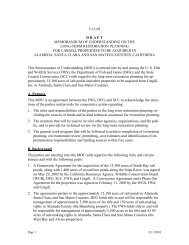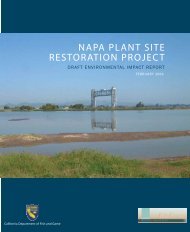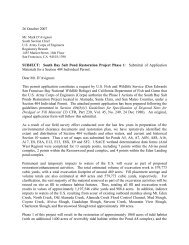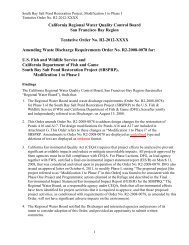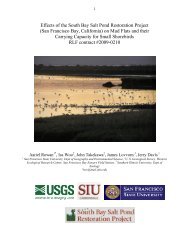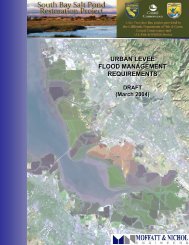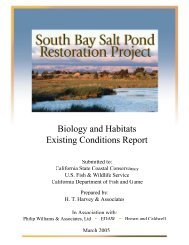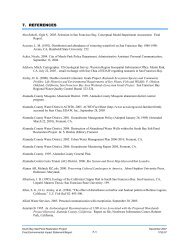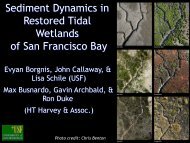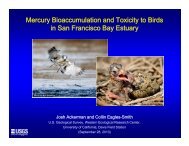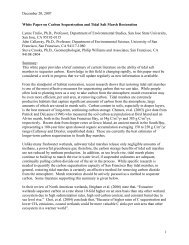M E M O R A N D U M - South Bay Salt Pond Restoration Project
M E M O R A N D U M - South Bay Salt Pond Restoration Project
M E M O R A N D U M - South Bay Salt Pond Restoration Project
Create successful ePaper yourself
Turn your PDF publications into a flip-book with our unique Google optimized e-Paper software.
ATTACHMENT 1. PROJECT GOALS AND OBJECTIVES<br />
The project objectives were developed by the <strong>Project</strong> Management Team (PMT) with input from the<br />
Stakeholder Forum, Science Team, and Regulatory and Trustee Agency Group (PWA and others, 2004a).<br />
The overarching project goal and six project objectives, as adopted by the Stakeholder Forum on February<br />
18, 2004, are as follows:<br />
Overarching project goal:<br />
<strong>Restoration</strong> and enhancement of wetlands in the <strong>South</strong> San Francisco <strong>Bay</strong> while providing for flood<br />
management and wildlife-oriented public access and recreation.<br />
Objectives:<br />
1. Create, restore, or enhance habitats of sufficient size, function, and appropriate structure to:<br />
a. Promote restoration of native special-status plants and animals that depend on <strong>South</strong> San<br />
Francisco <strong>Bay</strong> habitat for all or part of their life cycles.<br />
b. Maintain current migratory bird species that utilize existing salt ponds and associated<br />
structures such as levees.<br />
c. Support increased abundance and diversity of native species in various <strong>South</strong> San<br />
Francisco <strong>Bay</strong> aquatic and terrestrial ecosystem components, including plants,<br />
invertebrates, fish, mammals, birds, reptiles and amphibians.<br />
2. Maintain or improve existing levels of flood protection in the <strong>South</strong> <strong>Bay</strong> area.<br />
3. Provide public access and recreational opportunities compatible with wildlife and habitat goals.<br />
4. Protect or improve existing levels of water and sediment quality in the <strong>South</strong> <strong>Bay</strong>, and take into<br />
account ecological risks caused by restoration.<br />
5. Implement design and management measures to maintain or improve current levels of vector<br />
management, control predation on special-status species, and manage the spread of non-native<br />
species.<br />
6. Protect the services provided by existing infrastructure (e.g., power lines, railroads).<br />
The Alternatives Development Framework methodology includes two additional evaluation factors in<br />
order to provide a complete basis for alternatives formulation and evaluation:<br />
7. Cost Effectiveness: Consider costs of implementation, management, and monitoring so that<br />
planned activities can be effectively executed with available funding.<br />
8. Environmental Impact: Promote environmental benefit and reduce impact in topics other than<br />
biology.<br />
<strong>South</strong> <strong>Bay</strong> <strong>Salt</strong> <strong>Pond</strong> <strong>Restoration</strong> <strong>Project</strong> January 2005<br />
Preliminary <strong>Project</strong> Alternatives Memorandum 36 1750.01





